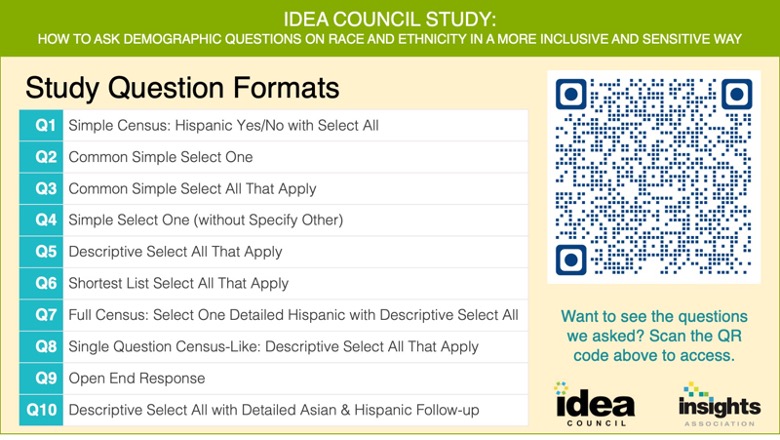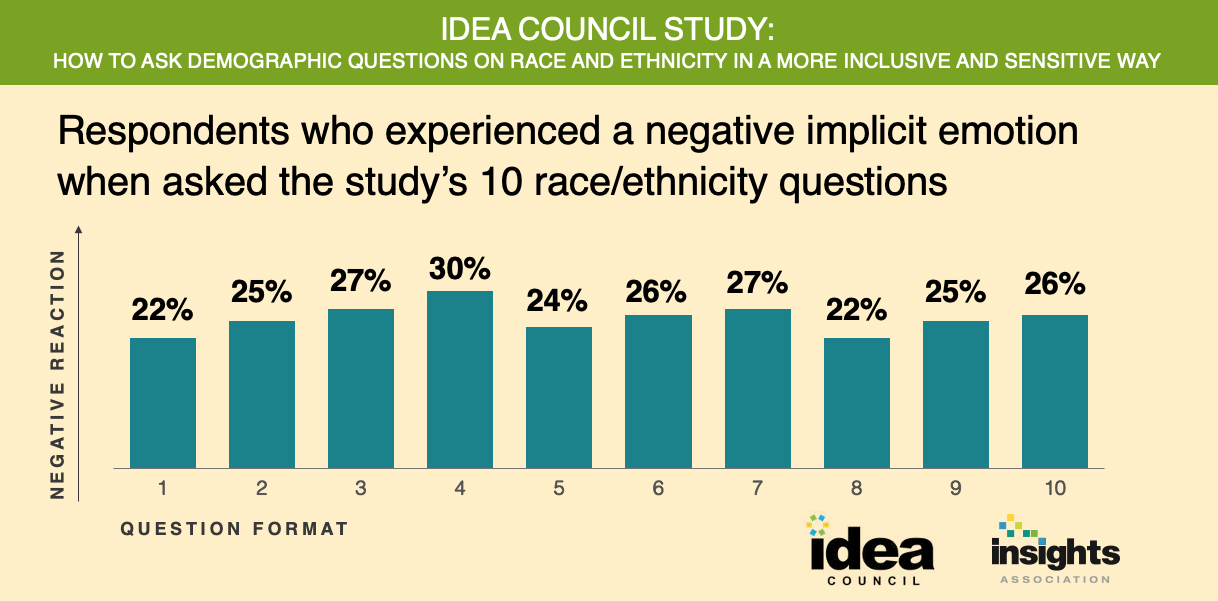Inclusive and diverse perspectives
Editor’s note: Lilah Raynor, Logica Research and Frankie Lipinski, Escalent; are members of the Insights Association IDEA Council. Sara Yang, InsightsNow, also collaborated on the study.
To do our jobs as insights professionals we need to understand how human behavior is changing – and to ensure we are keeping up with these changes we must do everything we can to incorporate inclusive and diverse perspectives in market research. If we continue to rely on standard demographic collection methods, we will fall short of allowing people to express and define their diverse identities in an accurate way. In particular, allowing study participants to capture their true identity is increasingly important – this is especially true among younger generations. In the United States alone, the 2020 Census showed the most diverse population in the history of the country.
By 2044 more than half of the U.S. population is expected to belong to a group other than non-Hispanic White, and by 2060 one in five Americans are expected to have been born outside of the country. The way we ask about race and ethnicity in market research – if we ask at all – needs to keep up. Market researchers and insights professionals need a new framework for inclusivity that leads to higher quality data and more impactful insights.
Are your research findings truly representative?
When the demographic questions included in a study are not inclusive – or could even be perceived as offensive – important findings may be missed. Examining these questions for inclusive language will help researchers avoid alienating study participants, and ultimately drive better, more insightful research.
Improving demographic questions across the entire marketing research and insight industry
The Insights Association’s IDEA Council recently created a research-on-research initiative to uncover more inclusive and sensitive ways to ask demographic questions. The goal of this initiative was to have a more inclusive respondent experience and to address a persistent gap in representation in the population that the marketing research industry seeks to understand.
Genesis and phases of research
The first step of this study process took the form of a position paper published in the fall of 2021, “The Evolution of Demographic Questions” (registration required). This piece covered how to ask demographic questions on gender, sexual orientation and race and ethnicity, providing an extensive review of evolving terminology, current practices and initial recommendations. It also outlines the research needed to ensure that the insights industry is asking demographic questions the right way – to be inclusive and sensitive and to not alienate study participants or create any biases.
The resulting three-phase IDEA Council research initiative works to better understand research across categories of demographics questions:
- Phase one: Race and ethnicity question study (recently completed and discussed below).
- Phase two: Gender identity and sexual orientation.
- Phase three: Access and ability.
Key considerations: Race and ethnicity
The first phase of the IDEA Council’s research-on-research initiative covers how to ask about race and ethnicity. Some of the key considerations of the study were to look at how market research studies are serving study participants, how to improve the respondent experience in answering these questions – and if we really need to ask these questions for effective insights.
Study details, methodology and research approaches
The online study included 4,892 United States-based respondents sourced from five different online panels. Sample was balanced across gender, age, income, U.S. region and the tags the panel companies had initially on race and ethnicity. It was deployed in both English and Spanish.
The methods used included implicit testing, index scoring, paired comparison, question wording deep dives and open-ended perception questions to test 10 different race and ethnicity questions. The questions included those identified in the initial position paper, the 2020 U.S. Census question and others established through extensive industry research.

To drive a deeper level of understanding, implicit testing allowed the study to gauge subconscious positive and negative reactions to the questions.
Key findings and respondent reactions
Overall, the majority of study participants had positive reactions when asked about race or ethnicity, but at the same time positive emotions were often combined with negative emotions. For example, one study participant states: “I have no problem stating that I am Black. The only issue I have is when it says African American. When referring to white, we don't say European American. So, I prefer Black. And I proudly state this. I love when they ask my race.”
Almost one quarter of respondents had a negative implicit reaction across any of the 10 different ways race and ethnicity were asked. One in seven felt offended by being asked the question. This was especially true for younger respondents, those identifying as multiple races or another race and Black/African American respondents. Some participants even felt suspicious about why the question was being asked or questioned why the company was asking the question.

One of the main findings from the study is the importance of allowing study participants to be able to select multiple responses. The most successful race and ethnicity questions in the study provided more descriptive options, combined ethnicity and race into one question, and allowed for multi-select or open-ended answers. From a study response: “Having restrictive options like most surveys exclude a lot of people who are more than one race and do not identify with one race over the other.”
Demographics and younger generation insights
One interesting data point is that younger generations are more likely to react negatively to race and ethnicity questions. Significantly more Gen Z respondents are confused (27%), frustrated (24%) and offended (20%) compared to those in any other generation. This group is acutely aware of missteps in demographic questions, and any lack of inclusivity throws up a red flag. They are waiting for us to figure it out, and anxious to have an opportunity to express themselves more fully.
Determining necessity of race or ethnicity questions
Many times, a study may not need to ask race or ethnicity questions, but they are included anyway as a default part of research. Researchers need to look closely at the necessity of these questions by asking questions like: Do we really need to know race or ethnicity to ensure a representative sample? Do we need to look at specific races or ethnicities in the results? If the answer is yes, there are best practices now for how to ask these questions and meet representative quota targets.
Demographic questions: Takeaways for research structures
- Studies should ask race and ethnicity only if needed, and researchers need to consider the objectives, audience and context of the study to determine if these questions are necessary.
- If it is determined that race and ethnicity data are needed, use the recommended approaches from top-performing questions that are available in the presentation.
- Allow multiple responses – we exclude large groups of people when we only have single select response options.
- Have detailed and inclusive response options – this is key; people need to see themselves in the response choices.
- Use “prefer to self-identify” and/or include "not listed" with write-in options. Don't use “other.” Other alienates people.
- Include a “Prefer not to answer" option so participants may opt out of the question.
- As an industry, continued testing is needed to evolve in the available methods for collecting demographics. By the year 2055, the United States will have no racial or ethnic majority group and continuing to evolve to ensure inclusivity of all populations will be important.
This research holds great importance in initiating a shift in the market research world as we strive for inclusion and equity, and for the best insights we can. Since being unveiled at the IA conference in Philadelphia, the study’s results have been presented at in-person industry events, including the Quirk’s Event.
You may download the “On Good Terms” presentation here (registration required).
Lilah Raynor of Logica Research is a member of the Insights Association IDEA Council and led the collaborative initiative for the IDEA Council. Sara Yang of Insights Now contributed to the management, design, execution, analysis and presentation of the research, and Frankie Lipinski of Escalent contributed to the management, analysis and presentation of the research. The authors want to thank Keyona Osborne-Pannall of AccelerateSG and Jennah Jodoin of Material+ who contributed to the analysis and presentation of the study. The Insights Association IDEA Council is made up of 17 diverse members who are passionate about increasing inclusion, diversity, equity and access in the insights industry. Members contributed to various points in the research design and analysis, marketing and communications, and conferences and visibility efforts. The Insights Association IDEA Council would also like to thank the sponsors of this study, including InsightsNow, Logica Research and Escalent for the design, execution and analysis of the study; Cint, Dynata, Kantar, InnovateMR and Tap Research for providing sample; Nuance for coding open-ended questions; G3 Translate for translation; and Confirmit for hosting.
The next phase of research will be a study on gender and sexual orientation identity. For this, the IDEA Council will apply study approaches similar to this first wave and utilize learnings from the position paper, “The Evolution of Demographic Questions,” (registration required) to better understand preferences and feelings toward different ways of asking these questions. Look for an upcoming presentation of the results through Women in Research (WIRe) this summer.
If you’re interested in supporting this ongoing research initiative through sponsorship and funding, e-mail IDEACouncil@insightsassociation.org.
